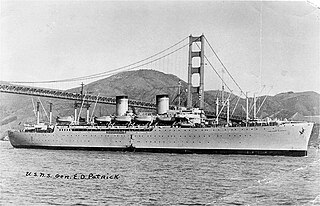 USS General M. M. Patrick (T-AP-150), probably arriving in the Port of Los Angeles, California, at the conclusion of a "Magic Carpet" voyage from the Philippines, 28 January 1946. | |
| History | |
|---|---|
| Name | General M. M. Patrick |
| Namesake | Mason Mathews Patrick |
| Ordered | as a Type C4-S-A1 hull, MC hull 702 |
| Awarded | 3 March 1942 |
| Builder | Permanente Metals Corporation, Yard No. 3, Richmond, California [1] |
| Cost | $9,967,243.62 [2] |
| Yard number | 16 |
| Way number | 2 |
| Laid down | 24 January 1944 |
| Launched | 21 June 1944 |
| Sponsored by | Mrs. William E. Lyne |
| Commissioned | 4 September 1944 |
| Decommissioned | 8 March 1946 |
| Stricken | 20 March 1946 |
| Identification |
|
| Fate | Transferred to the Maritime Commission (MARCOM), 30 August 1946 |
 USAT General M. M. Patrick, underway off Tacoma, Washington, in August 1948. The gun tubs are still in place but the armaments have been removed. Additional lifeboats added with war-time life rafts removed. | |
| Name | General M. M. Patrick |
| Operator | US Army |
| In service | 1946 |
| Out of service | 1950 |
| Fate | Transferred to the US Navy, 1 March 1950 |
 | |
| Name | General M. M. Patrick |
| Operator | Military Sea Transport Service (MSTS) |
| In service | 1 March 1950 |
| Out of service | 16 October 1958 |
| Stricken | 20 March 1946 |
| Identification | Hull symbol: T-AP-150 |
| Honors and awards | 2 × Battle Stars |
| Fate | Laid up in the National Defense Reserve Fleet, Olympia, Washington, 16 October 1958 |
| Name | Boston |
| Owner | Container Ship Chartering Service, Inc. |
| Operator | Sea-Land Service, Inc. |
| Renamed | June 1968 |
| Refit | converted to container ship, 1968 |
| Fate | Sold to Litton Industries Leasing Corp., 17 September 1968 |
| Name | Boston |
| Owner | Litton Industries Leasing Corp. |
| Fate | Sold to Reynolds Leasing Corp., 28 February 1975 |
| Name | Boston |
| Owner | Reynolds Leasing Corp. |
| Fate | Sold to Sea-Land Service, Inc., 12 February 1987 |
| Name | Boston |
| Owner | Sea-Land Service, Inc. |
| Fate | Sold for scrapping, May 1988 |
| General characteristics [3] | |
| Class and type | General G. O. Squier-class transport ship |
| Displacement | |
| Length | 522 ft 10 in (159.36 m) |
| Beam | 71 ft 6 in (21.79 m) |
| Draft | 26 ft 6 in (8.08 m) |
| Installed power |
|
| Propulsion |
|
| Speed | 16.5 kn (30.6 km/h; 19.0 mph) |
| Capacity | 3,343 troops |
| Complement | 425 (officers and enlisted) |
| Armament |
|
USS General M. M. Patrick (AP-150) was a General G. O. Squier-class transport ship built for the US Navy in World War II. She was named in honor of US Army general Mason Mathews Patrick, a graduate of the US Military Academy in 1886. Promoted to major general in 1918, during World War I, he was appointed Chief of the Army Air Service, the position he held until his retirement in 1927. After the Armistice, he represented the A.E.F. at the Paris Peace Conference.
Contents
- Construction
- Service history
- Commercial service
- Awards
- Further reading
- References
- Bibliography
- External links
She was transferred to the US Army as USAT General M. M. Patrick in 1946. On 1 March 1950, she was transferred to the Military Sea Transportation Service (MSTS) as USNS General M. M. Patrick (T-AP-150). She was later sold for commercial operation and rebuilt as a container ship.




















